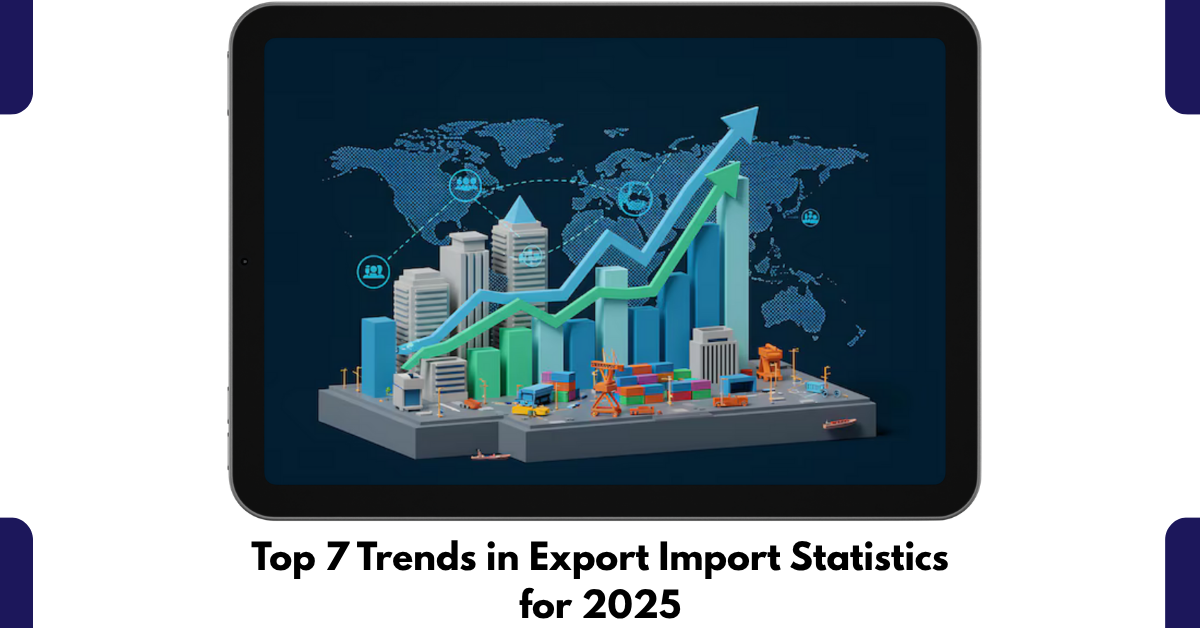The Changing Landscape of Global Trade
The global trade ecosystem is entering a new era. From the rise of digital customs systems to evolving geopolitical alliances, 2025 marks a turning point for businesses tracking India exports and imports data. export import statistics As global economies stabilize post-disruption, trade flows are being reshaped by advanced analytics, sustainability mandates, and digitized documentation. The modern exporter or importer is no longer just a participant in trade — they are a data-driven strategist navigating a constantly transforming marketplace.
Understanding these transformations begins with recognizing the new metrics of success. Import export data by country, once confined to basic customs records, now reveals deeper patterns about consumer behavior, trade partnerships, and supply chain resilience. Companies that can decode these signals hold the key to competitive advantage.
The following analysis highlights the Top 7 Trends in Export Import Statistics for 2025 — trends that define not just what is being traded, but how trade itself is evolving.
1. Rise of Real-Time Trade Intelligence Systems
In 2025, instant access to global trade data has moved from luxury to necessity. Businesses are embracing Free import export data online platforms that provide live dashboards of shipments, commodities, and tariffs. These tools eliminate guesswork by integrating customs feeds, financial transactions, and logistics updates in real time. export import statistics
Unlike traditional reports, today’s data ecosystems process millions of entries daily — connecting ports, banks, and ministries under one digital umbrella. Exporters in India are increasingly relying on DGFT Import Export data systems to gain precise insights into emerging markets, pricing dynamics, and partner reliability.
The ability to act on real-time intelligence translates directly into reduced operational costs and faster decision-making. In short, agility is now the most valuable export commodity.
2. AI-Powered Predictive Analytics in Trade Forecasting
Artificial Intelligence has revolutionized trade forecasting by predicting shipment trends before they materialize. Algorithms now process India import data and correlate it with macroeconomic indicators, weather disruptions, and currency movements to forecast trade volumes with high precision.
In 2025, AI tools don’t just describe trends — they anticipate them. export import statistics For instance, machine learning models trained on India export import data year wise pdf reports can predict which product categories will see demand surges in specific regions. Such predictive capabilities enable exporters and importers to allocate resources effectively, mitigate risks, and negotiate favorable contracts.
AI has become a silent yet strategic partner in the export-import industry, converting raw numbers into actionable foresight.
3. Transparency Through Blockchain Integration
Blockchain technology is redefining how stakeholders view trust and verification. In 2025, export-import documentation, once burdened by delays and fraud, is being secured through immutable blockchain ledgers. This ensures end-to-end transparency across the trade cycle — from customs clearance to banking transactions. export import statistics
Exporters using Export import data Bank systems now benefit from seamless verification of Letters of Credit, invoices, and compliance reports. Moreover, blockchain’s distributed framework reduces paperwork, accelerates clearance, and prevents data tampering.
For businesses analyzing Free import export data with importer name, blockchain offers unparalleled accuracy. Each transaction recorded on a digital ledger becomes a permanent record of authenticity — a guarantee that is invaluable in global commerce.
4. Sustainability Becomes a Trade Metric
Environmental compliance is no longer optional; it’s a determining factor in trade partnerships. export import statistics Global buyers now evaluate exporters based on carbon-neutral supply chains, ethical sourcing, and adherence to sustainable trade practices.
India exports and imports data increasingly highlight the growth of eco-friendly sectors such as renewable energy components, biodegradable packaging materials, and electric vehicle parts. Policymakers and investors are rewarding companies that align with sustainability benchmarks, pushing trade in greener directions. export import statistics
For data analysts, this shift represents a new dimension of competitiveness — where environmental impact metrics become as vital as profit margins.
5. Digitization of Customs and Documentation
Manual customs paperwork is rapidly disappearing. Governments are investing heavily in digital trade facilitation systems that connect exporters, importers, and regulators seamlessly. Platforms linked to DGFT Import Export data and port authorities now enable exporters to file documents electronically, verify authenticity, and track shipments without human intervention.
These developments have reduced clearance times from days to hours, allowing small and mid-sized exporters to compete on equal footing with global players. Automation has also minimized data entry errors and improved regulatory compliance — creating a more transparent and efficient trade ecosystem. export import statistics
The transition to paperless trade isn’t just a convenience — it’s a competitive necessity in 2025.
6. Cross-Border Data Harmonization and AI Compliance
With the surge in global trade analytics, regulatory bodies are emphasizing standardized data formats to ensure interoperability between nations. The harmonization of Import export data by country is crucial to building a unified global trade database accessible to all stakeholders. export import statistics
AI-driven compliance systems now automatically cross-check trade documentation against international regulations, reducing violations and ensuring smoother transactions. Exporters analyzing India import data can identify anomalies instantly, allowing early detection of potential compliance issues.
This era of intelligent regulation ensures smoother audits, faster approvals, and enhanced accountability in global trade operations.
7. Expansion of Data Accessibility and Democratization
2025 is witnessing the democratization of trade data. Once restricted to government bodies and large enterprises, Free import export data online portals have opened the door for startups, small exporters, and market researchers to access valuable trade insights. export import statistics
Open data ecosystems now empower smaller players to analyze Free import export data with importer name, benchmark performance, and identify global opportunities previously reserved for industry giants.
Simultaneously, integration with India export import data year wise pdf databases has enabled researchers to study long-term trends and project future trade patterns. The accessibility revolution has turned trade data into a shared resource — a digital equalizer fostering innovation and inclusion. export import statistics
Conclusion: The Future of Trade Data in 2025
Trade in 2025 is more transparent, intelligent, and interconnected than ever before. From Export import data Bank innovations to AI-powered forecasting, every layer of the export-import process is being redefined by data-driven insights. Businesses that adapt to these changes — embracing automation, sustainability, and real-time intelligence — will lead the next wave of global commerce.
The evolution of India exports and imports data is not merely a reflection of what is traded but how efficiently, ethically, and intelligently global trade now operates. Those who harness the full potential of data-driven trade will shape the economic blueprint of the future. export import statistics
FAQs on Export Import Statistics
Q1. What are export-import statistics?
Export-import statistics represent data on goods and services traded between countries, showing volumes, values, and trade balances.
Q2. Why are export-import statistics important for businesses?
They help companies identify potential markets, forecast demand, monitor competitors, and make informed export or import decisions.
Q3. How can I access export-import statistics for India?
You can access them through platforms like DGFT, India Trade Portal, or specialized tools like Allinfo India’s Export Data services.
Q4. What is the difference between export and import statistics?
Export statistics show goods sent out of a country, while import statistics record goods brought in — together, they indicate trade performance.
Q5. Can export-import data help new exporters?
Yes, analyzing trade data helps new exporters find high-demand products, active buyer countries, and price trends before entering global markets.



